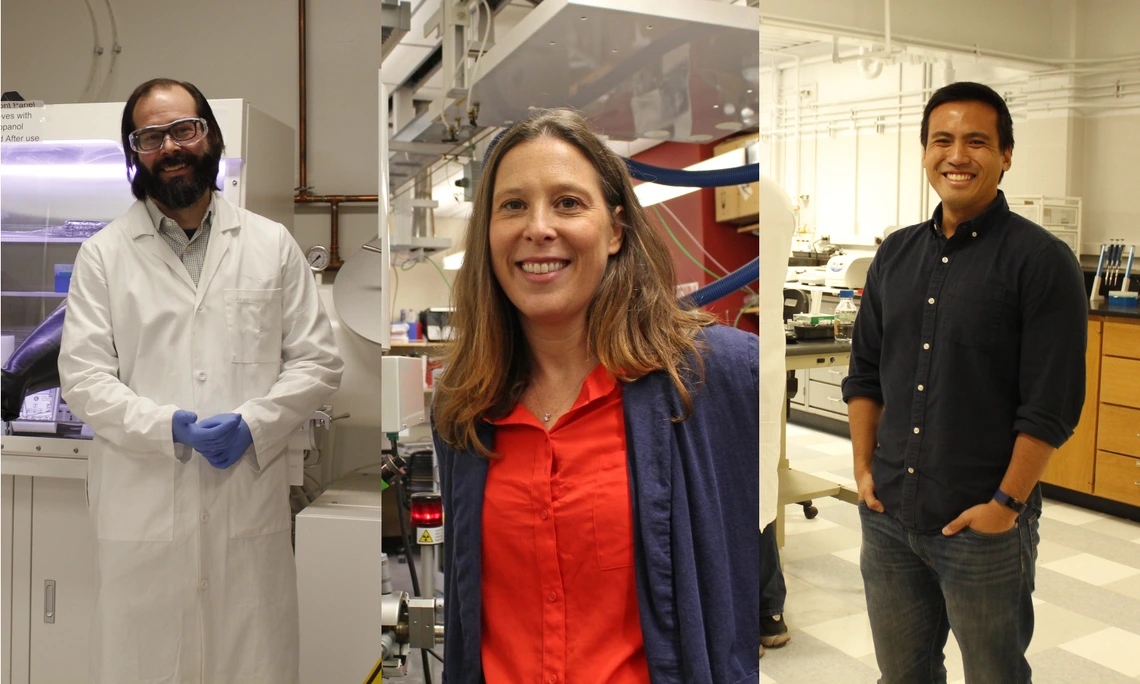Three of CHEE’s Newest Researchers Receive Major Grants

Research expenditures in CHEE are up, thanks in large part to the hard work of some of the department’s newest faculty members.
“I am so excited about the grants that our new faculty have received,” said Department Chair Kim Ogden. “It shows the quality of the individuals that we hired. Suchol Savagatrup received an Army Young Investigator Award to work on sensors, and Adam Printz received a highly competitive DOE grant to advance perovskite devices. Erin Ratcliff recently joined our department, and her ability to obtain funding from a variety of federal agencies is amazing for a recently tenured faculty member.”
Adam Printz
Adam Printz, who joined the department in fall 2018, received a three-year, $700,000 dollar grant from the Department of Energy to improve scaled production methods for perovskite thin films. Perovskites are lightweight minerals that have a broad range of applications, particularly for photovoltaics, a form of solar power. They can be made into ink and printed onto flexible pieces of plastic, making them more lightweight and portable than typical silicon-based electronic devices.
“To me, the flexibility and light weight are the key competitive advantages for perovskites in applications such as wearables, avionics and disaster relief power where size and portability are critical constraints,” said Printz. “All of these benefits come without any significant tradeoff in device performance.”
Printz will be scaling a method he developed called restricted area printing by ink drawing, or RAPID, to improve the performance and scalability of perovskite photovoltaic technologies. RAPID addresses the most substantial challenges in producing this technology by increasing stability and offering technicians more control over the process.
Erin Ratcliff
Erin Ratcliff is one of the department’s newest faculty members, though she started as a faculty member in the Department of Materials Science and Engineering in 2014. She is a co-investigator on Printz’s project and also leading her own projects to advance perovskite production. In 2020, she received an $861,000 grant from the Office of Naval Research, or ONR.
Most recently, she received an additional $246,000 grant from the ONR Defense University Research Instrumentation Program to build a unique scanning photoelectrochemical microscopy system. Her work will focus on stabilizing interfaces in perovskite solar cells. While the ability to print perovskites like ink onto ultrathin electronic devices is handy, the way that the “ink” dries and interacts with other layers in the device can impact the quality of the resulting semiconductor. Less-than-ideal quality leads to degradation and eventually, device failure.
“Solvent evaporation and quick formation into solids can leave behind defects that can impact the performance and stability of the materials,” Ratcliff said. “If we can understand the role of these defects we can design better materials. This grant is for a new equipment capability at UArizona to image these defects at nanometer length scales.”
Suchol Savagatrup
Suchol Savagatrup joined the department in 2019, and received a Young Investigator Award of $360,000 from the Army Research Office in spring 2021. His work involves using liquid sensors to detect a variety of contaminants in drinking water. Traditional sensors are designed to detect specific contaminants, such as lead or PFAS, but Savagatrup’s method uses an array of sensors which can be trained to detect different kinds of contaminants.
This abundance of sensors will be unique in that they are liquid, rather than solid. Instead of dipping a solid sensor into water, the approach uses droplets of liquid, submerged in the water being tested, to create many different points of contact.
“If you’re dipping a solid sensor into the water, you can only measure the interface where it makes contact, between air and water,” Savagatrup said. “With these liquid materials, essentially oil droplets, each droplet has its own interface. If we have hundreds of these functionalized droplets, we get hundreds of different sources of information.”
